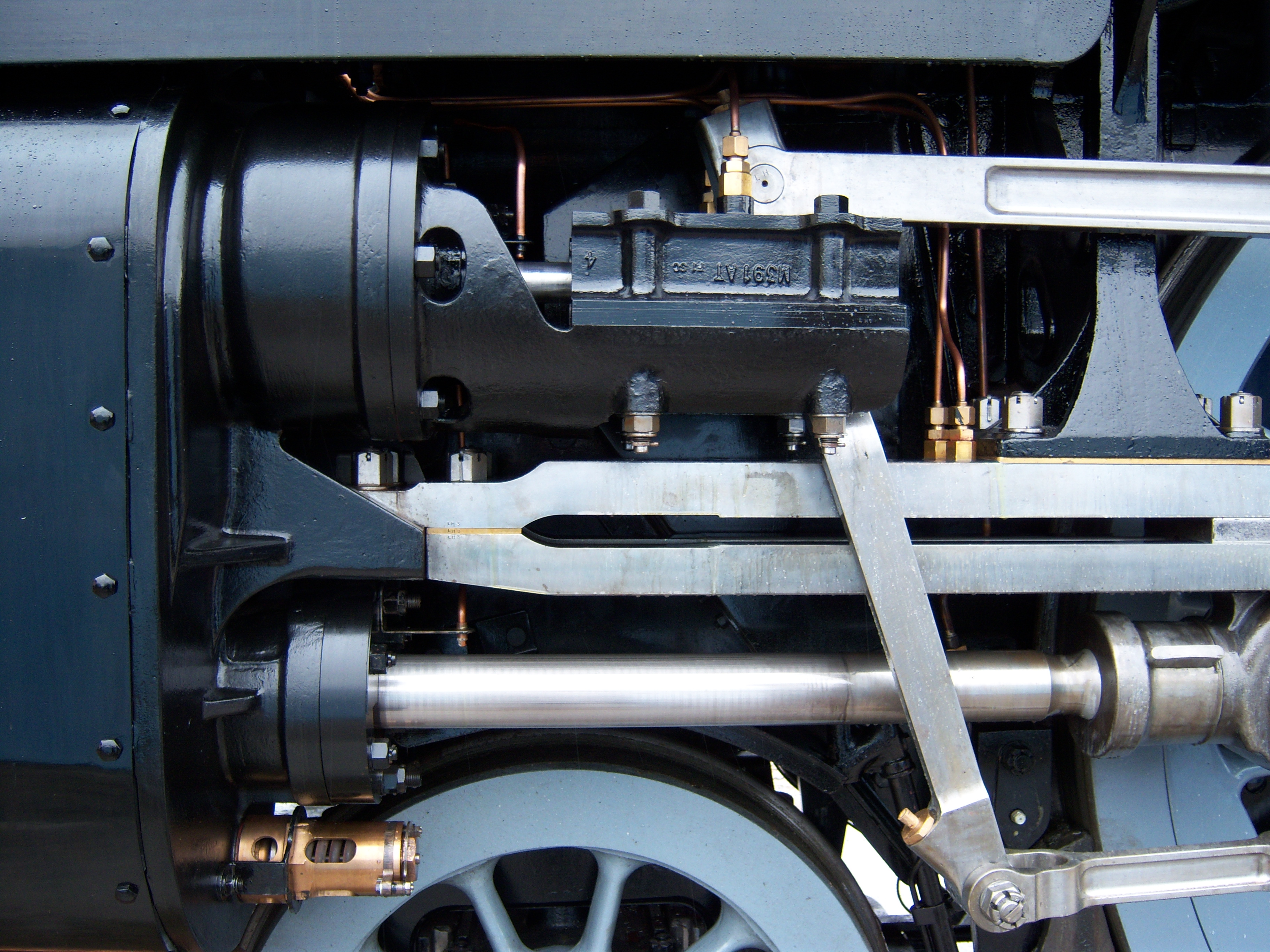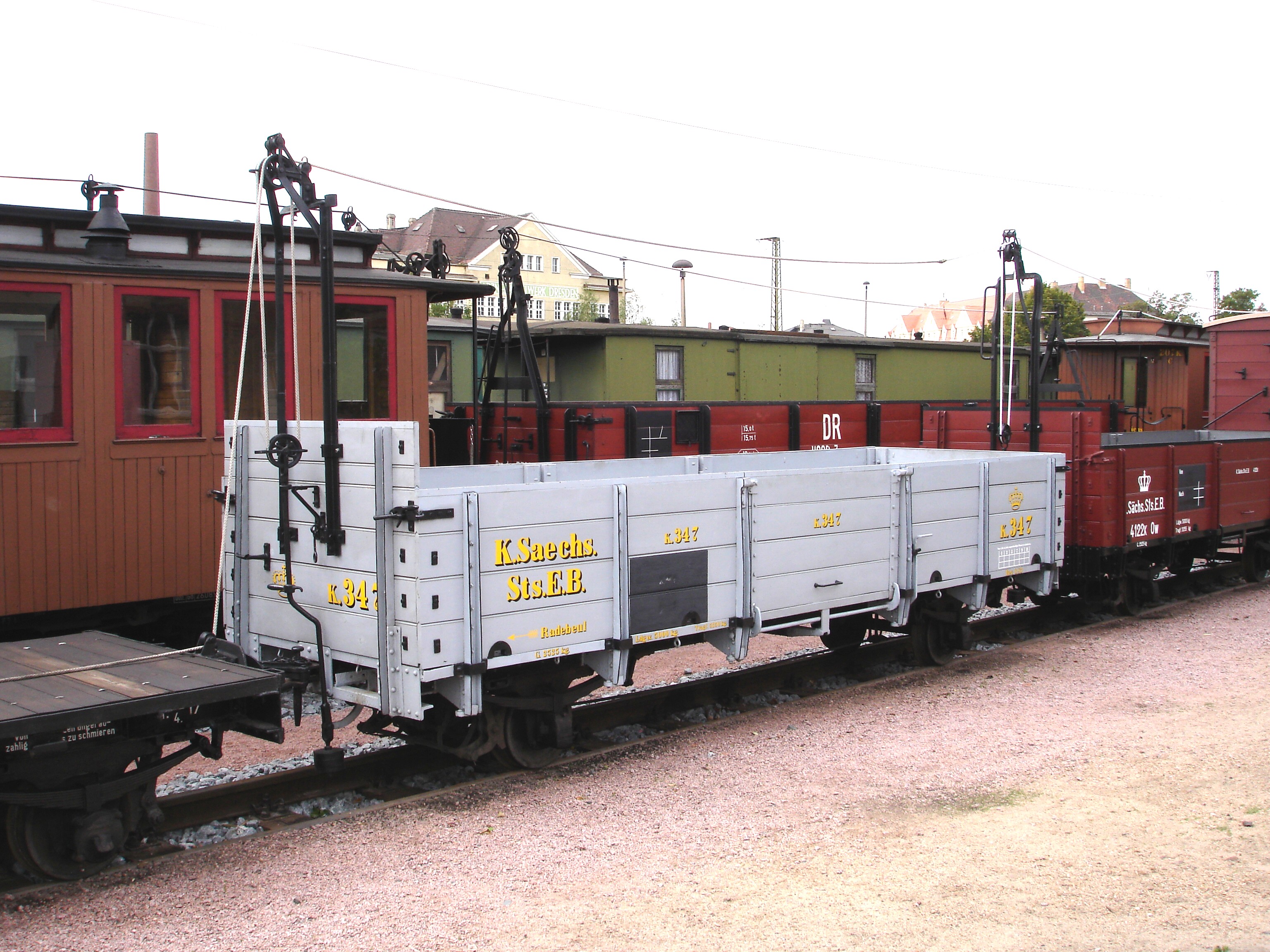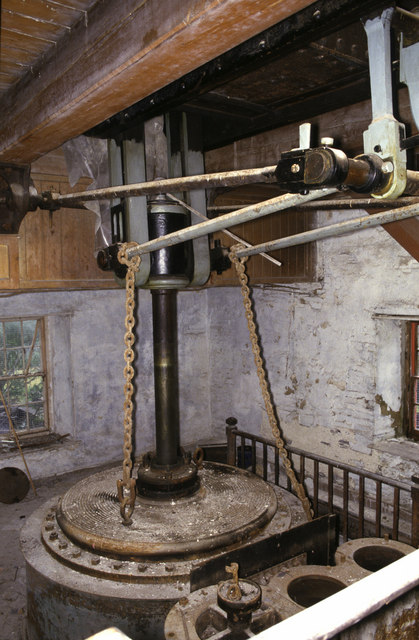|
Steam Brake
A steam brake is a type of brake for steam locomotives and their tenders, whereby a steam cylinder works directly on the brake linkages. Steam brakes were primarily used on railways where vacuum brakes were used to brake the train, but where there was no vacuum brake on the steam locomotive itself, as for example in the United Kingdom, or where there was only a cable-operated brake (e.g. a Heberlein brake) running along the train, like for example in Saxony on the narrow gauge railways. Steam brakes are usually found today on heritage steam locomotives. Operation Steam is supplied to the steam brake cylinders from the locomotive boiler A boiler is a closed vessel in which fluid (generally water) is heated. The fluid does not necessarily boil. The heated or vaporized fluid exits the boiler for use in various processes or heating applications, including water heating, centra ... via a valve (the brake valve) which may have several fixed settings or be infinitely vari ... [...More Info...] [...Related Items...] OR: [Wikipedia] [Google] [Baidu] |
Steam Locomotive
A steam locomotive is a locomotive that provides the force to move itself and other vehicles by means of the expansion of steam. It is fuelled by burning combustible material (usually coal, Fuel oil, oil or, rarely, Wood fuel, wood) to heat water in the locomotive's Boiler (power generation), boiler to the point where it becomes gaseous and its volume increases 1,700 times. Functionally, it is a steam engine on wheels. In most locomotives, the steam is admitted alternately to each end of its Steam locomotive components, cylinders in which pistons are mechanically connected to the locomotive's main wheels. Fuel and water supplies are usually carried with the locomotive, either on the locomotive itself or in a Tender (rail), tender coupled to it. #Variations, Variations in this general design include electrically powered boilers, turbines in place of pistons, and using steam generated externally. Steam locomotives were first developed in the United Kingdom of Great Britain an ... [...More Info...] [...Related Items...] OR: [Wikipedia] [Google] [Baidu] |
Tender (rail)
A tender is a special rail vehicle hauled by a steam locomotive containing its fuel (wood, coal, oil or torrefied biomass) and water. Steam locomotives consume large quantities of water compared to the quantity of fuel, so their tenders are necessary to keep them running over long distances. A locomotive that pulls a tender is called a tender locomotive. Locomotives that do not have tenders and carry all their fuel and water on board are called '' tank locomotives'' or ''tank engines''. A corridor tender is a locomotive tender with a passageway to one side, allowing crew changes on the fly. A brake tender is a tender that is heavy and used (primarily) to provide greater braking efficiency. General functions The largest steam locomotives are semi-permanently coupled by a drawbar to a tender that carries the water and fuel. The fuel source used depends on what is economically available locally. In the UK and parts of Europe, a plentiful supply of coal made this the obvious ... [...More Info...] [...Related Items...] OR: [Wikipedia] [Google] [Baidu] |
Cylinder (locomotive)
The cylinder is the power-producing element of the steam engine powering a steam locomotive. The cylinder (engine), cylinder is made pressure-tight with end covers and a piston; a valve distributes the steam to the ends of the cylinder. Cylinders were initially cast iron, but later made of steel. The cylinder casting includes other features such as (in the case of Stephenson's Rocket) valve ports and mounting feet. The last big American locomotives incorporated the cylinders as part of huge one-piece steel castings that were the Locomotive frame, main frame of the locomotive. Renewable wearing surfaces were needed inside the cylinders and provided by cast-iron bushings. The way the valve controlled the steam entering and leaving the cylinder was known as steam distribution and shown by the shape of the indicator diagram. What happened to the steam inside the cylinder was assessed separately from what happened in the boiler and how much friction the moving machinery had to cope wit ... [...More Info...] [...Related Items...] OR: [Wikipedia] [Google] [Baidu] |
Railways
Rail transport (also known as train transport) is a means of transport using wheeled vehicles running in tracks, which usually consist of two parallel steel rails. Rail transport is one of the two primary means of land transport, next to road transport. It is used for about 8% of passenger and freight transport globally, thanks to its energy efficiency and potentially high speed. Rolling stock on rails generally encounters lower frictional resistance than rubber-tyred road vehicles, allowing rail cars to be coupled into longer trains. Power is usually provided by diesel or electric locomotives. While railway transport is capital-intensive and less flexible than road transport, it can carry heavy loads of passengers and cargo with greater energy efficiency and safety. Precursors of railways driven by human or animal power have existed since antiquity, but modern rail transport began with the invention of the steam locomotive in the United Kingdom at the beginning of the ... [...More Info...] [...Related Items...] OR: [Wikipedia] [Google] [Baidu] |
Vacuum Brakes
The vacuum brake is a braking system employed on trains and introduced in the mid-1860s. A variant, the automatic vacuum brake system, became almost universal in British train equipment and in countries influenced by British practice. Vacuum brakes also enjoyed a brief period of adoption in the United States, primarily on narrow-gauge railroads. Their limitations caused them to be progressively superseded by compressed air systems starting in the United Kingdom from the 1970s onward. The vacuum brake system is now obsolete; it is not in large-scale usage anywhere in the world, other than in South Africa, largely supplanted by air brakes. Introduction In the earliest days of railways, trains were slowed or stopped by the application of manually applied brakes on the locomotive and in brake vehicles through the train, and later by steam power brakes on locomotives. This was clearly unsatisfactory, given the slow and unreliable response times (each brake being separately applied ... [...More Info...] [...Related Items...] OR: [Wikipedia] [Google] [Baidu] |
United Kingdom
The United Kingdom of Great Britain and Northern Ireland, commonly known as the United Kingdom (UK) or Britain, is a country in Northwestern Europe, off the coast of European mainland, the continental mainland. It comprises England, Scotland, Wales and Northern Ireland. The UK includes the island of Great Britain, the north-eastern part of the island of Ireland, and most of List of islands of the United Kingdom, the smaller islands within the British Isles, covering . Northern Ireland shares Republic of Ireland–United Kingdom border, a land border with the Republic of Ireland; otherwise, the UK is surrounded by the Atlantic Ocean, the North Sea, the English Channel, the Celtic Sea and the Irish Sea. It maintains sovereignty over the British Overseas Territories, which are located across various oceans and seas globally. The UK had an estimated population of over 68.2 million people in 2023. The capital and largest city of both England and the UK is London. The cities o ... [...More Info...] [...Related Items...] OR: [Wikipedia] [Google] [Baidu] |
Heberlein Brake
A Heberlein brake is a continuous railway brake used in Germany that is applied by means of a mechanical cable. Train braking is therefore initiated centrally from the locomotive using a winder. This causes the brake clips to be applied on individual wagons, assisted by a Servomechanism, servo system which makes use of the rotation of the axle. The brakes operate automatically if the cable snaps. A typical feature of ''Heberlein'' brakes is the clearly visible cable run on top of the wagons, but cables can also be led underneath the wagons, as on the ''Spreewaldbahn'' railway line. ''Heberlein'' brakes were eventually largely replaced by compressed-air brakes or, sometimes, by vacuum brakes on narrow gauge railway vehicles. Modern use The ''Heberlein'' brake is still permitted as an operating brake on German railways due to it being both continuous and automatic, and at the low speeds on narrow gauge lines this means it is perfectly safe. On several narrow gauge railways in Sax ... [...More Info...] [...Related Items...] OR: [Wikipedia] [Google] [Baidu] |
Kingdom Of Saxony
The Kingdom of Saxony () was a German monarchy in Central Europe between 1806 and 1918, the successor of the Electorate of Saxony. It joined the Confederation of the Rhine after the dissolution of the Holy Roman Empire, later joining the German Confederation after Napoleon was defeated in 1815. From 1871, it was part of the German Empire. It became a Free state (polity)#Germany, free state of the Weimar Republic in 1918 after the end of World War I and the abdication of King Frederick Augustus III of Saxony, Frederick Augustus III. Its capital was Dresden, and its modern successor is the Saxony, Free State of Saxony. History Napoleonic era and the German Confederation Before 1806, Saxony was part of the Holy Roman Empire, a thousand-year-old entity that had become highly decentralised over the centuries. The rulers of the Electorate of Saxony of the House of Wettin had held the title of prince-elector, elector for several centuries. The Holy Roman Empire was dissolved in Augu ... [...More Info...] [...Related Items...] OR: [Wikipedia] [Google] [Baidu] |
Narrow Gauge
A narrow-gauge railway (narrow-gauge railroad in the US) is a railway with a track gauge (distance between the rails) narrower than . Most narrow-gauge railways are between and . Since narrow-gauge railways are usually built with Minimum railway curve radius, tighter curves, smaller structure gauges, and lighter Rail profile, rails; they can be less costly to build, equip, and operate than standard- or broad-gauge railways (particularly in mountainous or difficult terrain). Lower-cost narrow-gauge railways are often used in mountainous terrain, where engineering savings can be substantial. Lower-cost narrow-gauge railways are often built to serve industries as well as sparsely populated communities where the traffic potential would not justify the cost of a standard- or broad-gauge line. Narrow-gauge railways have specialised use in mines and other environments where a small structure gauge necessitates a small loading gauge. In some countries, narrow gauge is the standard: Ja ... [...More Info...] [...Related Items...] OR: [Wikipedia] [Google] [Baidu] |
Boiler
A boiler is a closed vessel in which fluid (generally water) is heated. The fluid does not necessarily boil. The heated or vaporized fluid exits the boiler for use in various processes or heating applications, including water heating, central heating, boiler-based power generation, cooking, and sanitation. Heat sources In a fossil fuel power plant using a steam cycle for power generation, the primary heat source will be combustion of coal, oil, or natural gas. In some cases byproduct fuel such as the carbon monoxide rich offgasses of a coke battery can be burned to heat a boiler; biofuels such as bagasse, where economically available, can also be used. In a nuclear power plant, boilers called steam generators are heated by the heat produced by nuclear fission. Where a large volume of hot gas is available from some process, a heat recovery steam generator or recovery boiler can use the heat to produce steam, with little or no extra fuel consumed; such a configuration is ... [...More Info...] [...Related Items...] OR: [Wikipedia] [Google] [Baidu] |
Piston Rod
In a piston engine, a piston rod joins a piston to the crosshead and thus to the connecting rod that drives the crankshaft or (for steam locomotives) the driving wheels. Internal combustion engines, and in particular all current automobile engines, do not generally have piston rods. Instead they use trunk pistons, where the piston and crosshead are combined and so do not need a rod between them. The term ''piston rod'' has been used as a synonym for 'connecting rod' in the context of these engines. Engines with crossheads have piston rods. These include most steam locomotives and some large marine diesel engines. Compressor piston rods are made from various types of steel depending on the stress levels and gas compression. Steam engines The first single-acting beam engines, such as Newcomen's, had a single power stroke acting downwards. Rather than a piston rod, they used an iron chain. This could transmit a tensile force, but not a compression force pushing upwards. Th ... [...More Info...] [...Related Items...] OR: [Wikipedia] [Google] [Baidu] |
Brake Block
A railway brake is a type of brake used on the cars of railway trains to enable deceleration, control acceleration (downhill) or to keep them immobile when parked. While the basic principle is similar to that on road vehicle usage, operational features are more complex because of the need to control multiple linked carriages and to be effective on vehicles left without a prime mover. Clasp brakes are one type of brakes historically used on trains. Early developments In the earliest days of railways, braking technology was primitive. The first trains had brakes operative on the locomotive tender and on vehicles in the train, where "porters" or, in the United States brakemen, travelling for the purpose on those vehicles operated the brakes. Some railways fitted a special deep-noted brake whistle to locomotives to indicate to the porters the necessity to apply the brakes. All the brakes at this stage of development were applied by operation of a screw and linkage to brake blo ... [...More Info...] [...Related Items...] OR: [Wikipedia] [Google] [Baidu] |









